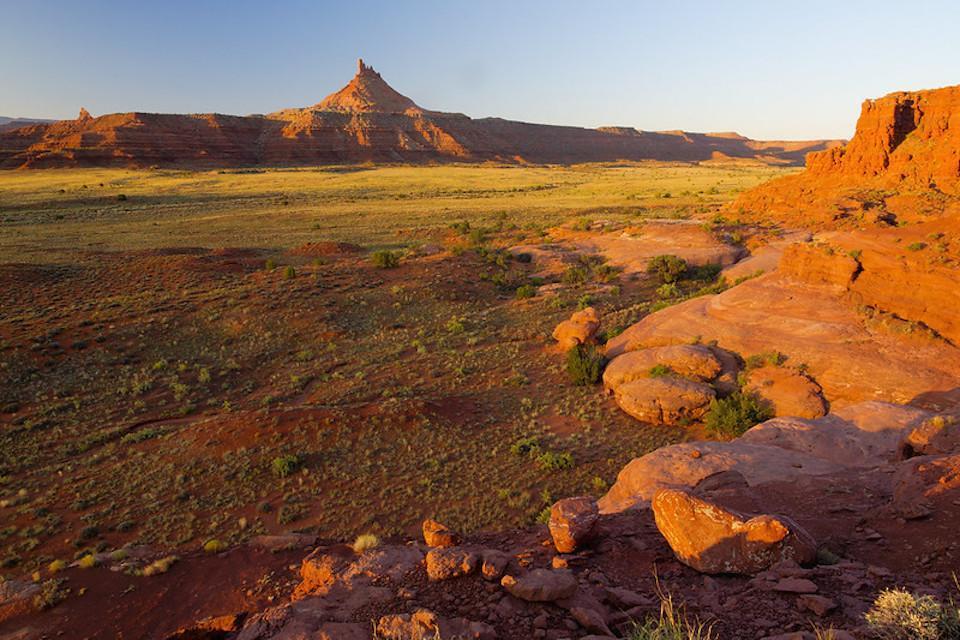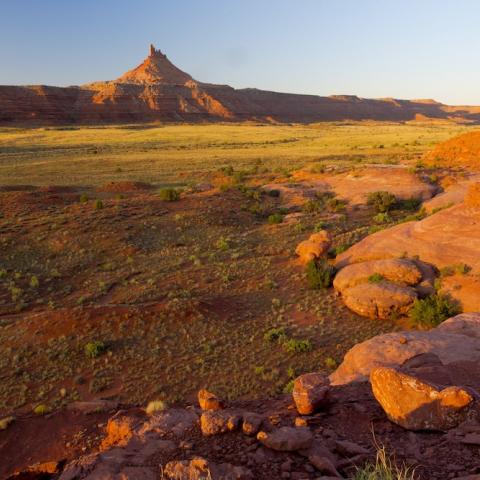
Utah's attorney general has appealed to the 10th U.S. Circuit Court of Appeals a lower court's dismissal of the state's lawsuit over the boundaries of Bears Ears and Grand Staircase-Escalante national monuments/BLM file, Bob Wick
Utah's attorney general, indicating he's willing to eventually approach the U.S. Supreme Court over President Biden's boundary revisions to Bears Ears and Grand Staircase-Escalante national monuments, has appealed a lower court's ruling against the state.
Late last week U.S. District Judge David Nuffer said the state was in no position to second guess Biden's decision to restore the monuments' original boundaries as set by Presidents Clinton and Obama.
The legal battle hinged on the authority The Antiquities Act grants the president of the United States to unilaterally designate national monuments. Former President Trump flew to Salt Lake City in December 2017 to issue presidential proclamations that sheared nearly 2 million acres from the two monuments; the 1.9-million-acre Grand Staircase-Escalante had been designated by Clinton in 1996, while the 1.3-million-acre Bears Ears had been designated by Obama in 2016.
Bears Ears as originally designated was home to multiple culturally significant and archaeological sites dating as far back as 11,000 BCE. The land is still used today by tribal members, who continually visit it to conduct religious ceremonies and other traditional practices. Grand Staircase, meanwhile, is extremely rich in paleontological resources, with nearly 150 scientists having said the monument “hosts one of the highest concentrations of dinosaur fossils in the world,” and that only 6 percent has been surveyed, and that “the potential for future discovery is tremendous.”
But Trump maintained that Clinton and Obama overreached their authority under The Antiquities Act by creating national monuments larger than needed to protect historic, cultural, archaeological, and paleontological resources. The Republican then issued an executive order to cut Grand Staircase by a bit more than 1 million acres and broke it into three monuments known as Grand Staircase, Escalante Canyons, and Kaiparowits. Bears Ears shrank to a bit more than 201,000 acres in the Indian Creek and Shash Jáa units from its original size of 1.3 million acres.
Biden in the fall of 2021 reversed Trump's actions in a move both to keep a promise to restore the boundaries and also to uphold "the longstanding principle that America’s national parks, monuments, and other protected areas are to be protected for all time and for all people," the White House said at the time.
In their lawsuit, Utah authorities claimed Biden went too far by restoring the original monument boundaries, arguing that the boundaries he restored were "not confined to qualifying historic landmarks, historic and prehistoric structures, or other objects of historic or scientific interest."
Judge Nuffer, however, ruled that, "It has long been held that where Congress has authorized a public officer to take some specified legislative action when in his judgment that action is necessary or appropriate to carry out the policy of Congress, the judgment of the officer as to the existence of the facts calling for that action is not subject to review. President Biden’s judgment in drafting and issuing the Proclamations as he sees fit is not an action reviewable by a district court."
On Monday Utah's attorney general, Sean D. Reyes, filed a motion to appeal the lower court's ruling to the 10th U.S. Circuit Court of Appeal. His office said it was "a necessary stop before any trip to the U.S. Supreme Court."
“All along, the State of Utah has sought appropriate protections of the precious, unique area in the heart of the Bears Ears and Grand Staircase-Escalante regions,” Reyes said. “But the current monument designations are overkill by millions of acres. President Biden’s designations exceed his authority. We eagerly anticipate explaining to the Tenth Circuit why the law and the facts are on our side.”



 Support Essential Coverage of Essential Places
Support Essential Coverage of Essential Places







Comments
They can appeal all they like, but there's no chance that they will get this decision overturned. Why? Simple. Binding Supreme Court precedent. Large monuments were settled as valid under the Antiquities Act in 1920. Further, that states have no standing to challenge monuments is also well settled, both Alaska and Wyoming challenged monuments in their states and lost, in the case of Alaska, 15 of the 17 monuments were at least 1 million acres in size and 2 of them were TEN million acres in size. every single one of the 17 were upheld as valid, Carter could have set aside 250 million acres as monuments and every single one of them would have been upheld. The courts have been clear on this- it is not the size of the monument that matters, but what it is protecting. Utah was trying to claim that out of the thousands of sites and objects within Bears Ears, only 9 sites, covering some 6000 acres, merited protection. Which is patently absurd , as all of the thousands of sites warrant protection and that necessitates a large area. As the judge in Wyoming v Franke held in 1945" It is enough that the president believes that there are objects in the area worthy of protection for him to declare it as a monument '
It is obvious in both Bears Ears and Grandstaircase Eacslante that there are thousands, if not tens of thousands, or deserving areas. The tribes were asking for 1.9 million acres, Obama settled in about 1.35 million, Trump actually added 11000 acres, and Biden 's moves left the monument at 1, 362, 000 acres, still much smaller than what the tribes were asking for.
In the case of Grand Staircase, this is the second challenge to the monument Utah has made, in 2004 the courts ruled in Utah Assoc. of Counties v Bush that Clintons original designation of 1.7 million acres was valid. Congress adjusted the borders of the monument adding 180000 acres after everything was said and done. Biden's moves actually leave the monument about 10000 acres smaller than it was in 1998.
Not so fast on the precedent argument. This current Supreme Court doesn't care or regard what is precedent (ie Roe v Wade, Affirmative Action, etc). But they may be unwilling to overturn this case because it is based on congressional legislation rather than an executive order or judicial decision.
Good point Kyle. this Supreme Court doesnt give a toss for precedent. However,John Roberts is clearly on his own in regards to narrowing the scope of the Antiquities Act. Thats because none of the other 8 joined him in his griping about the Northeastern Canyons and Seamounts marine monument. I would bet that its been made pefectly clear to Roberts that any Supreme Court decision gutting the Antiquities Act will not be honored by the executive, who after all enforces the decisions of the court, the Court itself has no enforcement powers of its own. Not only that, people love their parks and monuments and would be extemely pissed off that the Supreme Court basically made it impossible to protect the nations special places, I mean, Congress has set aside fewer areas in 117 years than Presidents Clinton and Obama did in 16, they set aside 48 areas, Coingress has only set aside 44. The public would vote in a Democratic Congress in response, who would overturn that deecision via legislation. The Congress would likely remove monuments designations from judicial review entirely, in addition to removing monument limits in Alaska and Wyoming. After all if you are reinstating the Antiquities Act, why not give the president authority everywhere, as he had until 1950?